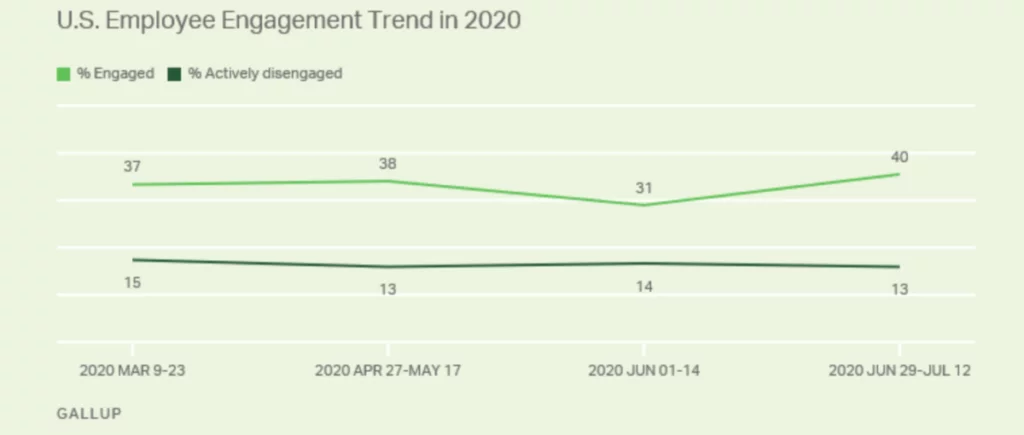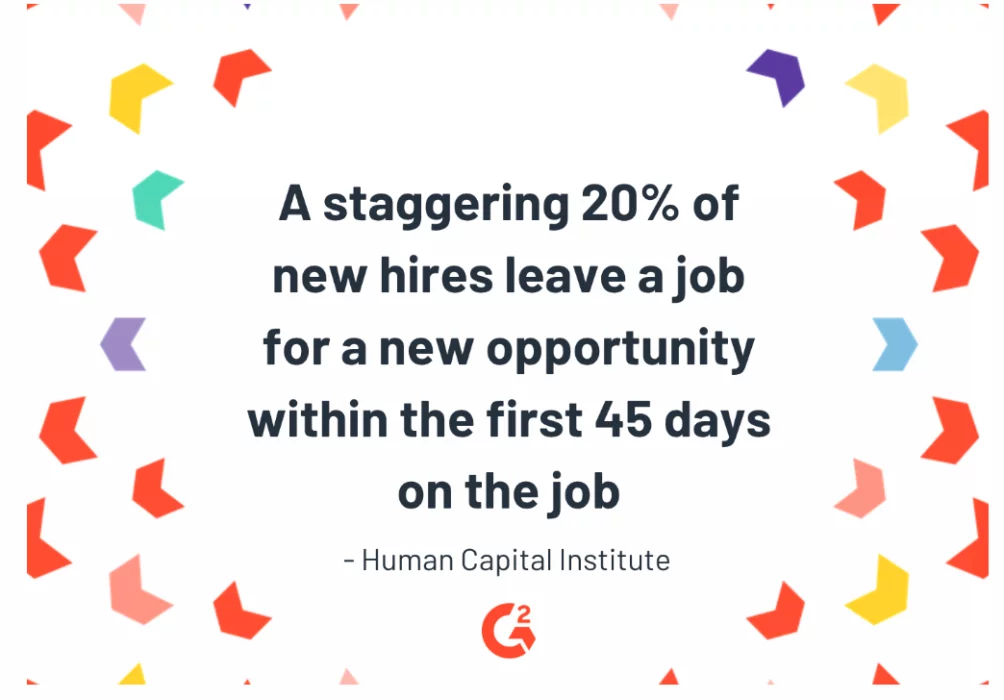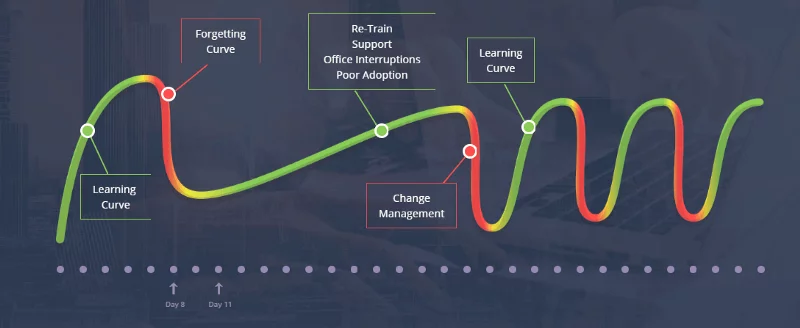Effective employee training and onboarding are the greatest predictors of a new hire’s success. So why do so many organizations still get it wrong?
Managers spend weeks vetting candidates to fill a vacant position. After hours of digging through resumes, talking on the phone, and interviewing applicants, they find the best person for the job.
Finally! Someone with all of the right experience and skills.
The manager is excited. The new employee is excited. But after a few weeks on the job, they still don’t seem to grasp their role in reaching the company’s goals. Or, they are struggling to use software independently and productively.
The enthusiasm your new hire first displayed has been replaced with stress and frustration.
Dive Deeper: How to Design a Superior Employee Training Manual
What went wrong?

The employee struggling in this scenario likely received inadequate employee training or onboarding. Although a promising candidate might appear qualified to dive into their new role, no one can succeed without the right kind of training and support.
The same rule applies when it comes to onboarding employees to use new software platforms or skill sets. Introducing a digital system to complete formerly manual tasks is a big adjustment. Using an updated version of the same system can even be a confusing and overwhelming experience.
What is employee training?
Employee training is the ongoing effort to provide staff with the right knowledge, skills, and experience required to succeed in their role and achieve business goals.
Employee training is crucial to ensuring your talented hires are positioned to fulfill their potential. Without a structured plan, informative curriculum, and routine check-ins, you can’t expect your employees to get very far.
Why employee training should be a top organizational priority
Employee onboarding accomplishes more than just gearing up a new hire to perform their duties. When done correctly, it can improve retention, increase employee performance and productivity, and boost satisfaction.
Following employee training best practices is critical to effective software adoption. Without it, your technology investment will lead to employee frustration and lower productivity.
Comprehensive training is also directly tied to employee engagement levels. When an employee first joins your company, they’re in the “honeymoon” phase — eager to work hard and prove themselves. But if your training doesn’t empower them to perform at the highest level, you can be sure engagement will drop.
Solid training produces higher employee engagement and productivity
Creating a comprehensive training plan requires significant time, energy, and participation from various colleagues. However, it’s integral to the success of a new employee. And when done correctly, it will yield your company a high ROI.
Gallup defines employee engagement as: determined by factors such as feeling clear about your role; having the right materials and equipment to do your job; having the opportunity to do what you do best; having strongly committed coworkers; and working with a common mission or purpose.
As of late, Gallup tracked that employee engagement is on the rise in spite of COVID-19, influencing employee performance metrics like profitability, productivity and employee turnover.

And according to a report from The Society of Human Resources Management, a formal onboarding process is linked to shorter time to productivity. The sooner a new hire becomes a meaningful contributor, the sooner they can become a true asset to the company.
Formal employee training helps with role clarity, which is a key prerequisite to productivity. Without clearly defined expectations, employee performance will suffer. Businesses lose an estimated $37 billion per year as a result of employees not understanding their role, according to the report.
In addition to role clarity, the SHRM found effective training encompasses three more categories:
- Self-efficacy: New employees who are confident they are doing their job well will be more motivated and successful.
- Social integration: This refers to the ease with which new employees meet and begin to work with organizational “insiders.” Social integration also includes feeling socially comfortable and accepted by their colleagues.
- Cultural fit: Understanding the organization’s values, politics, goals, and behavioral norms is critical to fitting in and succeeding in a new company.
A new hire onboarding process that addresses all four of these categories will help new employees become productive faster.
Like what you’re reading? Subscribe to the blog for fresh insights delivered right to your inbox!
Make your training program a gateway to enhanced productivity
Consider these tips to ensure your employee training process supports the goal of faster time to productivity.
- Identify training objectives. Start by writing down the skills and competencies your new employee needs to be successful in his or her role. Then think about what type of education they’ll require to gain them.
- Organize training in advance. When it comes to employee onboarding, “winging it” will not be not a successful approach. Plan training in advance to ensure the purpose of each session is clear to both trainer and trainee. Keep in mind that people retain more information when they actually use it, so incorporate hands-on training as much as possible.
- Open feedback loops. Don’t wait until the end of the onboarding process to solicit feedback from new hires. Ask them at the end of each session if they have questions, and if they think the training was effective. Doing so will help you improve your training, eliminate mistakes and also clarify any confusion for the employee.
Formal employee onboarding is critical for retention

Training helps reduce turnover, another significant source of waste for companies. The cost of replacing an employee can range from 50%-60% of his or her salary, the SHRM reported.
On top of the costs associated with employee turnover, high employee churn can have a profoundly negative influence on team performance, morale, and company culture.

On the other hand, employees who experienced great onboarding were 69% more likely to stay with the company for three years, according to a report from the SHRM.
Managers can improve retention by implementing these five simple measures into their employee training model:
- Establish good communication with the new hire before their first day. Maintain the dialogue with regular check-in meetings throughout and beyond the onboarding process.
- Clarify expectations and goals so there is no part of the new employee’s job description that’s ambiguous. If an employee is confused about their responsibilities, it’s unlikely that they’ll be able to perform them well.
- Don’t overlook the importance of cultural integration. Positive interpersonal interactions and strong working relationships are critical to individual and team success.
- Make professional and social networking simple by pairing the new hire with a “buddy” to help them learn the ropes. Let them meet with senior level employees in their line of work so they can understand the trajectory for promotion.
- Make technology easy to use. There are few things more daunting for a new employee than having to learn several new technology systems at once. Empower your employees to master new technology fast with contextual guidance and real-time support.
Better employee training helps increase resilience to the talent shortage
The McKinsey Global Institute estimates that by 2020, 95 million workers in advanced economies could lack necessary job skills. Many organizations already identify recruiting and retaining top-tier talent as a major challenge.
Without strong training and onboarding, employees will be unable to reach their potential. They’re also more likely to turn to competitors who offer superior development opportunities.
As the talent pool continues to dwindle, companies have fewer options to replace departing workers.
Onboarding new employees, as well as continuous professional development opportunities, are essential for maintaining top talent amid the growing talent shortage.
How to create an effective employee training plan

Now that we’ve clarified the many benefits of employee training and onboarding you might be asking, how do I create an effective training plan?
To define the answer that is right for your company, explore the following areas.
4 questions to consider when designing an employee training model
- Who does the training involve? In addition to the employees being trained, who in the company is best equipped to lead the training
- What do they need to know? What specific skills and knowledge do you want the employee to take away from the session?
- When should we hold the training sessions? Employees can’t learn everything at once, so you need to prioritize what they need to know right away, and what they can pick up later.
- How can we cater to a diverse audience? Everyone has a different learning style and different preferences for how to receive new information. Ask your new hires what kind of approach will work best for them, and deliver it.
Training should cater to each individual employee’s role and responsibilities. However, you can create a general template to guide the onboarding process for any new hire.
Continuity vs. personalization: Building a training plan template that fulfills all goals
Standardization is essential for maintaining continuity across the workforce. After all, there are certain competencies, processes, and information that all employees need to know. But at the same time, every individual employee has unique learning styles and responsibilities. So, how do you find the right balance?
The answer is an employee training plan template. By building the core structure of the training model — one that can be replicated for each employee — you can be sure the fundamentals are covered while leaving room for individualization.
Employee engagement is key to success. Onboarding, mentoring and ongoing support. Employees who identify a “best friend” at work are 7 times more likely to be engaged/effective. Culture wins! pic.twitter.com/t2YZevIIlQ
— Principal Pollock (@PollockLindsey) July 11, 2019
What does an employee training manual template consist of?
An effective employee training template should include the following four components.
- Predefined training objectives. Employees have a range of knowledge to gain and skills to acquire during the onboarding process. Ensure they understand these objectives by breaking them down into clearly articulated goals. Then design each training session around these goals. Make the purpose for each session explicit, and recap what information was covered at the end.
- A timeline. Every job requires different types of training, but it’s safe to assume the first few days or week in a new job includes the most training sessions. However, onboarding doesn’t end there. To be truly effective, training should extend beyond the first few weeks of a new hire’s tenure. Keep your training plan organized by creating a timeline that includes a schedule, the itinerary, and important milestones.
- Open channels of communication. Communication is integral for improving the employee training process. Ask everyone involved for feedback and suggestions to improve the training process and ensure it fits the new hire’s needs.
- Further development opportunities. Once employees have achieved the goals included in the training plan, they will need subsequent reinforcements to make sure they retain the new information long term. Keep employees engaged in the learning process by giving them ongoing professional development opportunities.
The biggest barriers to successful training
Many obstacles have the potential to derail your training and onboarding plan. These challenges are even more difficult to overcome in a digital workplace.
First, beginning a new job can be an overwhelming and intimidating process for new employees. They are much like aliens trying to navigate their way around a foreign planet.
Organizational issues also pose barriers to effective employee onboarding. Employee resistance, inadequate leadership training, and lack of motivation have the power to thwart your training plan, regardless of how carefully you crafted it.
Another barrier is the sheer volume of information new hires must learn in the first days and weeks at a company. Today, it’s normal for companies to use several enterprise platforms just to manage basic HR functions. On top of that, employees are typically expected to use other digital tools at a proficient level on a daily basis.
Finding the time to train new employees on all of these systems and integrate them into employees’ daily workflows is a significant challenge.
While some training managers prefer instructor-led training sessions or demonstrations, more progressive organizations are increasingly adopting tools that enable training to occur while an employee is actually using the software.
With on-screen, contextual guidance, employees have instant access to support and navigation tools as they complete their work on a given platform.
Don’t make these employee training mistakes
On top of these barriers, there are a few common mishaps training managers tend to repeat. Here are the top ones to avoid.
- Lack of preparation on the new hire’s first day
- Drowning them in information
- Boring them with dull tasks
- Failing to provide adequate technical support
- Lack of guidance from managers and mentors
- Unclear expectations for their role
Traditional methods of employee training for enterprise no longer suffice
Traditionally, companies relied on methods of training that pulled employees out of their work. After a training session — which could be an in-person classroom session, webinar, or instruction manual — the trainee would be required to apply the new information to their work independently.
While these employee training techniques might have sufficed in the pre-digital workplace, they are no match for the complexity and breadth of processes there is to learn on contemporary enterprise software. It’s simply impossible for employees to retain enough information from outdated training methods and effectively apply it when using software.
Since COVID-19 hit, companies have entered into a remote working mode. This required employees to have all of the digital tools at their fingertips in order to perform their daily tasks. When it comes to training and onboarding remotely, ensuring that new hires get all of the resources they need in a timely manner depends on an organization’s digital level of preparedness. Having a remote onboarding checklist is the first place to start but will also require managers, trainers and HR to be extra attentive to new hires as they train and onboard outside of the office.
Choose employee training solutions that are suited for the digital era

A successful employee requires a substantial investment of time and money. While effective training isn’t free, there are several hacks organizations can adopt to make their employee training process as cost-effective as possible.
For example, don’t go for the cheapest option. Old school training systems, such as textbooks, webinars, and instructor-led classroom sessions, may seem like the most affordable choice. However, your company will end up paying the high price of poorly trained staff and low employee productivity
Instead, invest in engaging, personalized training. Digital tools that include engaging, customizable, and contextual guidance are proven tools to support new learning and continuous reinforcement. This type of training will yield the highest ROI.
Increase knowledge retention with “learning in the flow of work”
Outdated training methods not only drain your resources, they don’t let important information stick in employees’ brains. Think about it — if you had to use a brand new software system for the first time, how much would you remember after watching your colleague demonstrate how to use a dozen different features?
According to Hermann Ebbinghaus’s theory of the learning curve, people forget most of what they learn almost instantly. He estimated that if you can absorb 100% of new information in one day, you will forget 50%-80% of what you learn each day afterward. After 30 days, you’ll retain just 2%-3% of the information.
In this case, the learning curve functions more as a forgetting curve, as illustrated below.

A more effective approach is experiential learning, or “learning in the flow of work,” a term coined by Josh Bersin, a world-renowned HR, talent, and learning analyst.
Learning in the flow of work describes training methods that allow employees to actually complete tasks while they learn them. For instance, instead of reading about Workday in a video tutorial or instruction manual, your employees will actually complete processes they’ll need to know.
The benefits of training that enables learning in the flow of work are many. First, it eliminates the gap between theory and practice, which automatically engages a person’s memory and accelerates learning. Second, it’s far more efficient, as it doesn’t require extra time dedicated to lengthy training sessions.
The sum effect of these two benefits is greater time-to-competency, long-term knowledge retention, and instant productivity.
The future of employee training: Contextual learning
Organizations have taken varied and evolving approaches to employee training over the years. As sophisticated technology continues to proliferate in the modern workplace, digital tools will play an increasingly dominant role in training and onboarding.
Traditional types of training, such as instructor-led classroom sessions, webinars, PowerPoint presentations, and textbooks, may have been the go-to choice in the past. Now, they’re being supplanted by digital solutions.
Contextual learning, which relies on machine learning and artificial intelligence, will play a growing role in future employee training solutions.
Contextual training is the superior digital training approach because it combines information on a user’s past behaviors and needs with intelligent guesses on what they will need to do in the future. It uses all of this intel to deliver real-time, tailored support at the moment of need.
When designing your employee training plan, there are many factors to consider, obstacles to anticipate, and decisions to make. The process may seem daunting, but if you invest in your employees, the return will be well worth it.

